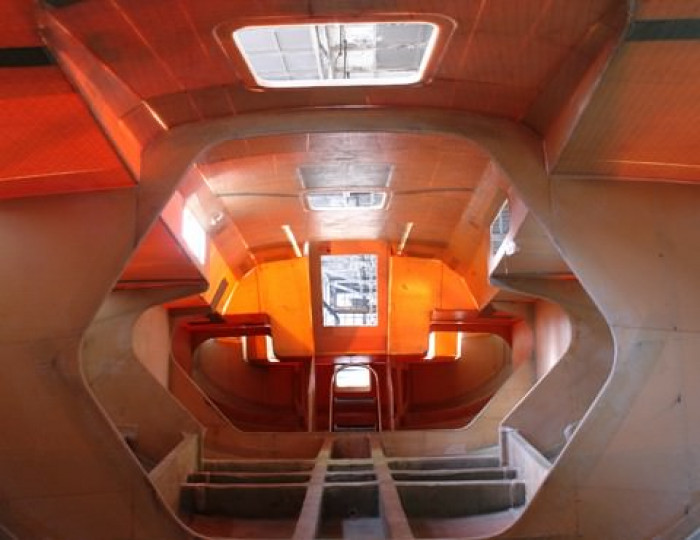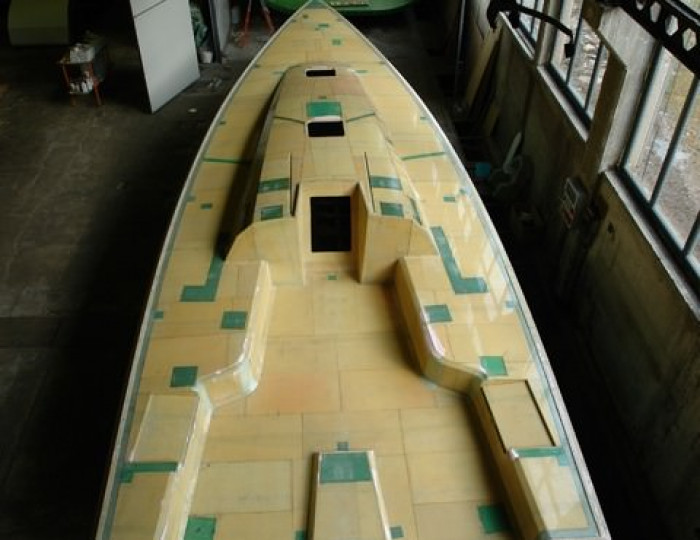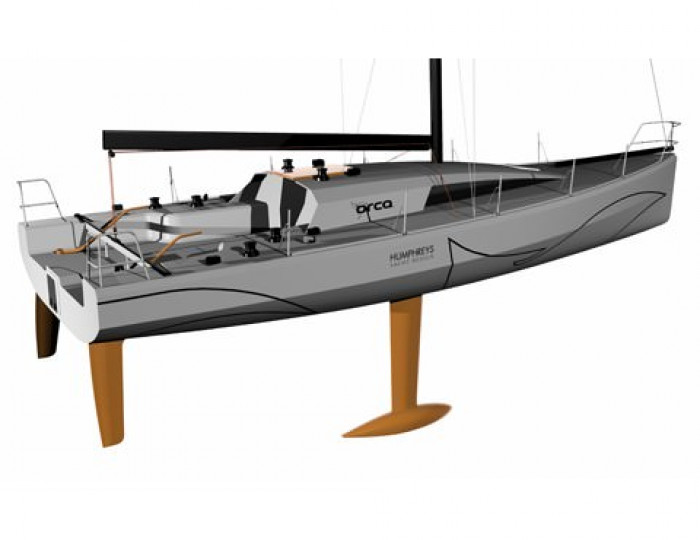Classy 40 (Seahorse – May 2008)
— 15 Apr 2008

With thirty boats competing in last autumn’s Transat Jaques Vabre and over sixty actively sailing worldwide, the Class 40 is a pretty exciting Class to be involved with right now and we at HYD are looking forward to the launch of our first Class 40 design. The ‘Orca 40’ is being series produced in Slovenia by the Ocean Tec Company and boat number one is now nearing completion and due for launch late this spring.
The timing of the Orca 40 design has been such that it has benefitted enormously from research and development work carried out on our Volvo 70 design for Team Russia, yielding a range of synergies that have helped to create an innovative Class 40 that is expected to have first class performance characteristics. Performance optimisation has been based heavily on meteorological profiles for the transoceanic classics, such as the Route du Rhum and Transat, working closely with Jure Jerman from the Slovenian Met Office who we have also been working closely with on the Volvo project.
Our development work for the Orca 40 commenced with a thorough investigation of the current Class 40 fleet. A number of emulations of competitive Class 40 designs were modelled and run through our VPP in order to determine each designs strengths and weaknesses. The next phase of development work involved the analysis of a systematic series of candidate hull designs looking primarily at the trade-off between form stability and wetted surface area through the variation of overall beam, waterline beam and rocker profile. These were run through our VPP, into which we had fed the meteorological profiles for the various trans-Atlantic races which gave us a strong basis from which to rank our candidate designs.
The maximum righting moment defined by the Class 40 rule is taken at 90 degrees heel, where form stability has negligible effect – i.e. it is really a vertical centre of gravity control. So, provided you can meet the maximum 90 deg righting moment target there are free gains to be had on top of this in terms of righting moment generated through form stability at sailing heel angles, though obviously the price you pay is likely to be in increased wetted surface area and hull structural weight due to increased panel sizes. In order to ensure this was all accounted for in our VPP study a detailed weight schedule was also developed from the outset as we wanted to keep a close eye on the effect increased beam and hull section shape would have on the weight of the composite structure.
Our initial VPP study and meetings we had with a number of top offshore sailors in relation to both the Class 40 and Volvo projects helped shape our design philosophy for the Orca 40 early on. With no maximum downwind sail area defined by the rule the limiting factor here is clearly how much can be accommodated by the rig geometry and managed by a single or shorthanded crew (remembering also that with such a tight limit on the number of sails carried, each sail must cover a wide range of wind speeds and angles). Considering also the potentially large upwind sail plan available to these boats (should an upwind optimised code 0 be carried) it became apparent from our VPP work that more miles could be lost by a light air optimised design in powered up conditions than by a more powerful design in underpowered conditions (with obviously some exceptions to the rule). Bearing all this in mind, it became clear that righting moment can help you in a number of ways. Firstly it gives you the ability to carry a large sail plan and to carry it higher up the wind range and up to shallower sailing angles. Possessing more righting moment can therefore broaden the range of each sail (important with only six sails, excluding storm sails, to choose from) and can reduce the number of sail changes required (particularly important when sailing shorthanded).
During this initial development phase we had also undertaken a comprehensive tank testing and CFD program as part of our Volvo 70 research and development. We will talk more about this in a future article but a number of areas investigated, such as hull volume distribution, chine height, behaviour in waves, spray shedding, etc, were also felt very relevant to our Class 40 design. As a result there are a number of features, such as the hull step and bluff bow which also feature on our Class 40 – albeit in a far less aggressive way!
In terms of general hull characteristics the Orca 40 has considerably more form stability than the majority of current generation Class 40 designs, with powerful hull sections and a pronounced chine, developing into a hull step forward of amidships. In order to ensure we meet the rule minimum displacement and maximum 90 deg righting moment targets, overall beam is approximately 50mm narrower than the rule maximum to reduce panel sizes and to save on hull and deck structural weight.
The deck layout design has received plenty of input from us as well as Kristian Hajnsek (8th in the 2007 Mini Transat) and Phil Sharp (Class 40 winner in the 2006 Route du Rhum). Kristian and Phil spent a good deal of time looking at the ergonomics and usability issues of a wide range of layout options based on all their single and shorthanded sailing experience. A full scale cockpit mock-up was built to fine tune some of these deck / cockpit design ideas which we could also heel to twenty degrees and was invaluable in terms of positioning winches and hardware for ease of operation, etc.
While the Orca 40 is being series produced from high quality production hull and deck female moulds there still remains a great deal of customisation possible with each new boat. Certainly we have found that speaking to a number of potential customers everyone has their own individual preferences, particularly when it comes to things like the deck layout. As a result we deemed it important to make alternative layout options available and give each new customer the choice when it comes to things like cuddy overhang size, winch and deck gear layout, bow sprit (articulating or fixed bolt on), etc.
With only 750 litres of available water ballast there are not too many options available to the designer in terms of ballasting arrangements. On the Orca 40 we have split the tanks into two per side and positioned them in such a way that when the tanks are full the water ballast centre of gravity is significantly further forward than on most current generation designs to aid upwind trim. The split tanks will help to add a few more gears to the design and with stackable weight forming a fairly significant proportion of the boats all up weight this can be used effectively to augment the water ballast in terms of righting moment and fore and aft trim.
Another particular area that we have spent a good deal of time focusing on is overall sailing balance. One of the challenging areas of designing a boat of this kind for shorthanded sailing is helm balance. For example the boat must be well behaved and light enough on the helm under a wide range of sail combinations and conditions to be handled easily by the autopilot whilst at the same time enough bite to prevent it from becoming too easy to wonder off course when helming at night. HYD have acquired a large knowledge base over the years with twin rudder designs, from race boats to production and cruising designs, and the wealth of tank testing and real life data available has been of real benefit. The Orca 40 rudders have been balanced with the aim to provide good feel for the helmsman whilst there is a generous planfom area to lighten straight line steering loads on the auto-pilot. The planform shape and section design has been derived from CFD work carried out on our Volvo 70 design. The rudders are positioned under the hull to minimise the effects of ventilation as well as being fairly high aspect ratio, both helping to increase induced drag efficiency. The rudders have also been positioned to encourage the windward rudder to fly at maintainable sailing heel angles to eliminate the parasitic drag of the non-steering rudder and its sometimes detrimental influence on helm balance.
In order to maximise our available downwind sail area the rig is situated quite far aft in the boat. This has also opened up the fore-triangle to fly large headsails, including an upwind optimised code 0 (with the long foot length being particularly useful in keeping the boat driving in sloppy seas) and provides us with an aerodynamically efficient high aspect ratio mainsail.
We considered a number of options for the keel fin construction and design from cast SG iron or steel to fabricated steel with a flange attachment to the hull or a posted tower type attachment. As an office we have had experience with a wide range of keel types but have always favoured the more homogenous forged billet route or high spec casting options, as we have always felt that fabricated fins are too fabricator dependent. While you can certainly save considerable weight in the fin by going down the fabricated route, since the class imposed the maximum righting moment limit there is no longer the drive to put as much weight as possible into the bulb and therefore shedding weight from the fin is now not necessarily such a performance driver. Our chosen option on the Orca 40 is a cast SG iron ‘H’ section fin with composite fore and aft fairings and a flange type attachment. This has enabled us to shave approximately 175kg out of the fin compared to a solid cast fin. The fore and aft fairings have been CNC milled in foam resulting in a much higher quality section shape and finer trailing edge than is otherwise possible with a solid cast or fabricated fin and then sheathed in glass to seal the entire fin.
The bulb length has been kept relatively short in order to minimise wetted surface area and torsion on the keel fin. Again due to the righting moment rule limit at 90 degrees heel there is not the same drive to lower the vertical centre of gravity so ultra long and heavily squashed bulbs are not going to be of as much benefit here compared to some other classes not restricted in this way. The bulb shape is an extrapolation of that used on our HYD42 IRC racer which was the result of an intensive CFD study investigating the induced drag effects of a range of bulb shape characteristics.
Construction of the Orca 40 utilises an advanced 3D infusion process developed by Ocean Tec. The hull shell, for example was vacuum infused in one hit along with the keel structure and bulkhead taping in order to reduce voids and to avoid additional secondary bonding. Epoxy, PVC foam, vacuum-infused sandwich laminates have been used throughout the build and this 3D infusion process has been repeated throughout the build wherever possible. Ocean Tec also have access to a 5-axis milling machine which was used to machine a metre length of the bow and stern on the hull plug, the coachroof on the deck plug, as well as the rudders, keel fin fairings, and a number of other miscellaneous items. All the build sections for the hull and deck plugs were CNC cut as were the frames in which the bulkheads were infused. There has also been a significant amount of material testing carried out at various stages of the build process to ensure designed panel strength, stiffness and weight targets have been reached. All in all Ocean Tec are offering considerably more in terms of build quality than many other semi-production and even one-off Class 40 offerings at an extremely competitive price.
The first Orca 40 due to splash this spring is a fully optimised Class 40 racer but Ocean Tec are also planning a cruiser-racer version using the same hull and deck moulds but with a slightly more comfortable, family cruising oriented interior. For more information please contact Gaber Bregant (gaber.bregant@gmail.com) at Ocean Tec.


